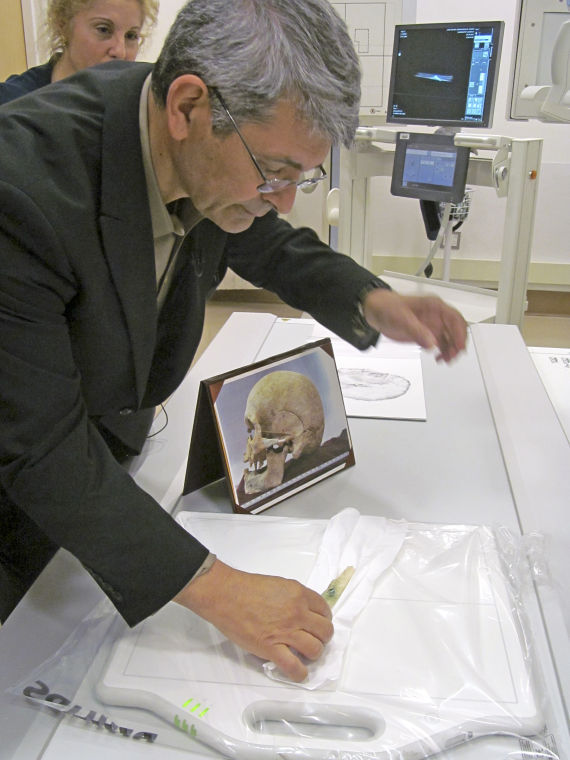Sometime during the reign of King Philip II of Macedonia, Alexander the Great’s father, a Greek soldier under his command suffered a debilitating battle wound when an arrow – possibly from the bow of an Athenian archer – struck his forearm and lodged there.
On Monday, in the North Shore-LIJ Medical Center’ radiology department in New Hyde Park, doctors X-rayed the 2,500-year-old ulnar bone of the unknown warrior and the bronze arrowhead still lodged in it, and determined that the arrow was barbed.
The doctors’ finding confirmed what Anagnostis Agelarakis, professor and chair of Anthropology at Adelphi University, had supposed all along.
Agelarakasm, who asked North Shore for its assistance after receiving the arm, said he had never seen a barbed arrow in a bone since he started going on archaeological digs as an undergraduate student in 1975.
“We’ve studied many Greek warriors. This is more rare than finding a diamond,” he said.
Dr. Helise Coopersmith, the North Shore-LIJ radiologist who read the enhanced X-ray, said she saw the distinct detail of the bronze arrowhead embedded in the bone.
Coopersmith said the man would have been unable to flex his fingers or his wrist of the arm where he sustained the wound. The arrowhead, she said, would have inhibited him from rotating the arm.
“I’m sure it was very painful,” she said, but noted the wound was “relatively superficial.”
Analyzing the X-ray was a rare opportunity for Coopersmith.
“We don’t get to see bones that are thousands of years old, or bones with barbed arrows embedded,” she said.
After receiving what he realized was an extremely rare forearm bone from archaeology colleagues in Greece, Agelarakis said, he concluded battlefield surgeons had removed the arrow shaft and attempted to remove the arrowhead by filing down two of three barbs on it, but couldn’t do anything about the third barb and then cleaned the wound.
“Now we have conclusive evidence that it was a barbed arrow – and evidence of scraping,” he said, adding the surgeons had to work fast because the warrior must have been bleeding profusely and would have died without immediate treatment.”
For Anagnostis Agelarakis, the man who eventually died in his late 50s or early 60s was a distant echo of the suffering endured by contemporary war veterans as the occasion of Memorial Day approached.
“He was a wounded vet who was disabled,” Agelarakis said. “Many times we don’t understand the pain of these people, or the obligation of these people. To commemorate the love and honor of our soldiers, we have the opportunity to look back in time to see the effects on our wounded warrior.”
From the writings of Hippocrates, he said, there is “ample evidence of surgical operations that were very complex.”
He said that although it was impossible to know the battle in which the wound was sustained, he said it was likely it took place at a time when King Philip was fighting a war to expand his territory among Greek city-states, including Athens. Historians record a battle in which King Philip’s army defeated a force of 3,000 Athenian warriors who landed at Methoni on the coast of Macedon in what is now northern Greece in 359 B.C.
And, Agelarakis said, Athenian archers were known to use a barbed bronze arrowhead of deadly design.
“That was its purpose, to not be able to be retrieved from the limb it hit. The barb was there to make it more lethal,” Aglelarakis said.
Agelarakis said a forensic reconstruction of the warrior’s skull, including what was left of his teeth revealed that he had lived to the age of 58 or 62 years. He was in relatively good health for a man living that long during Philip’s reign (382–336 BCE).
But the arrowhead in his arm left him unfit to fight again.
Adelphi sophomore anthropology student Kimberly Lombardi worked with Argie Agelarakis, professor Agelarakis’s wife, who teaches technical drawing and scientific illustration at Adelphi. She said using photos of the skull, she and Lombardi used an overlay technique to develop the man’s external features and seemingly bring him back to life.
“Taking into account the age of the individual at death, we added the wrinkles,” Aglelarakis said.
Agelarakis said the warrior may have been wounded “in the gray-haired period of his life,” but the wound didn’t ultimately contribute to his cause of death, which remains unknown.
While the bronze arrowpoint had visibly oxidized, turning green, it caused no infection because bronze acts as a biocide, inhibiting the growth of pathogens that could cause infection.
Agelarakis said the bone was discovered by Dr. Vasili Poulois, archeologist emeritus of the Greek Archeological Society. Agelarakis said Poulois discovered the remains of the warrior in a burial ground at the prefecture of Serres in the mid-1980s.
No artifacts indicated anything about the warrior’s social status. After what Agelarakis described as “a lot of bureaucracy and permits,” Poulois was able to ship the warrior’s forearm bone to Agelarakis.
“I am a caretaker,” said Agelarakis. Eventually, he said, the remains will go back to a museum in Greece.
A former student of Agelarakis, Dr. Carrina Lezzi, research coordinator at North Shore-LIJ, initiated the effort to enable Agelarakis to bring the forearm to the radiology department for further analysis.
The Adelphi anthropology scholar said he plans to publish his findings about the unknown warrior in journals of the American Para-Pathological Association and the American Institute of Archaeology.



